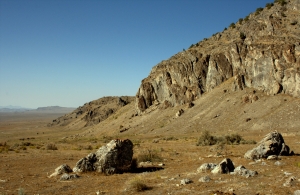Invasive Plants in the Sonoran Desert
By Garry Rogers
(First in series on Sonoran Desert invasive plants.)
Introduction to Invasive Plants in Deserts
Invasive species, like storm troopers leading the surging ruin of global warming, are demolishing Earth's ecosystems.
 Photograph: Once diverse landscape of small trees and tall Saguaro cactus was converted to impoverished shrubland after invasion by fire-prone plants.
Photograph: Once diverse landscape of small trees and tall Saguaro cactus was converted to impoverished shrubland after invasion by fire-prone plants.
Once they began crossing the oceans, Humans introduced thousands of plant species to new regions. Freed of the diseases and competitors of their homeland, some of the introduced species began spreading into native habitats. For instance, Cheatgrass (Bromus tectorum), introduced to the interior of the western U. S. during the 1800s began spreading, and now dominates many millions of acres. Such invasions produce vegetation with low structural diversity and biotic communities with low genetic diversity (Tellman 2002). In 2007, the U. S. Bureau of Land Management (BLM) had this to say about the state of the invasion of the western U.S.
There has also been a fourfold increase in invasive weed populations since 1985. Wildfires, drought, and invasive weeds are causing a steady degradation of soils, water quality and quantity, native plant communities, wildlife habitat, wilderness values, recreational opportunities, and livestock forage (BLM 2007: 30).
The BLM report agrees with many other conclusions. Across the western U. S., invading plants are reducing fire-return intervals below the recovery time needed by native vegetation (Mack 1989, Billings 1990, Turner et al. 2010). In many places, the change “has been so complete that only a sketchy picture of predisturbance conditions remains” (Radosevich et al. 2007: 26). Broad expanses of native grasslands, shrublands, and woodlands have become weedlands (e.g., Burcham 1970, Heady 1977, Mack 1981, Babbitt 1998).
 Photograph: A barren Great Basin landscape where native vegetation was removed by fire and replaced by Cheatgrass.
Photograph: A barren Great Basin landscape where native vegetation was removed by fire and replaced by Cheatgrass.
Combating the destructive impact of weeds on native ecosystems has become the central resource-conservation issue for managers of natural landscapes (Mau-Crimmins et al. 2005). According to the Sonoran Institute “Invasive species are the second most significant threat to biological diversity after direct habitat loss".
Failed Land Management
The loss of the lower-valley and foothill shrublands and sagebrush steppe of the Great Basin and Colorado Plateau is an enormous catastrophe. A similar loss of native vegetation is occurring across low-lying warmer Sonoran and Chihuahauan Deserts (Turner et al. 2010).
